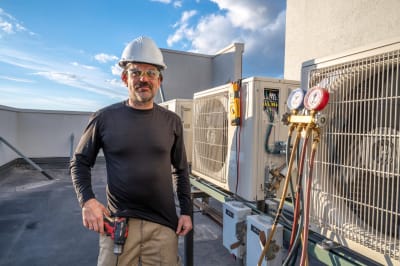Even though many have yet to learn this, it would be practically impossible to fly safely with aircraft mechanics. One of the most underrated roles in aviation, aircraft mechanics make sure that the aircraft is maintained correctly and that broken planes are promptly fixed so that they can take to the sky safely again.
To do all of these and do it effectively, rigorous training is a must. Now there are quite a few paths to becoming an aircraft mechanic. Most, however, choose to do so by attending an FAA-approved aviation maintenance technician school.
If you would also like to follow this path and become an aircraft mechanic in Baltimore, Maryland, below are a few alternatives to consider.
Choosing an Aviation Mechanic Training School in Baltimore
Aviation mechanics in Baltimore and everywhere must be at least 18 years old and speak, write, and read English fluently. The schools themselves do not necessarily set these requirements, but the FAA - which is the body that’s ultimately responsible for licensing and regulating the entire aviation industry.
To that end, we have ensured to list below only programs that are FAA approved. All of the entries below also hold themselves to a very high standard of education, providing both theoretical and hands-on training, which will be needed to pass the FAA licensing exam when the time comes.
Top Aircraft Mechanic Schools in Baltimore, Maryland
Without further ado, here are the two best schools to consider as an aspiring aircraft mechanic in Baltimore, Maryland:
Major Anderson Tuskegee Aviation Maintenance Academy
Baltimore, MD Online + Campus
Major Anderson Tuskegee Academy (MATAMA) is one of the premier non-profit aviation schools in Maryland and the entire country. Founded on creating value, the school boasts numerous aviation programs, including its aircraft mechanic program.
Tuition
$13,174 - $19,749Contact
(410) 761-0120
info@aviationmx.net
Pittsburgh Institute of Aeronautics, Hagerstown
Hagerstown, MD Online + Campus
Pittsburgh Institute of Aeronautics is another veritable alternative for aspiring aircraft mechanics in Baltimore, Maryland. While technically not located in Baltimore, in Hagerstown, PIA is close enough and offers an incredible program with over 90 years of experience.
Tuition
$39,655 - $42,140Contact
(240) 347-4805
info@pia.edu
Consider exploring aircraft mechanic schools in neighboring states:
Valuable Skills for the Trade
Along with technical theoretical and hands-on education, aspiring aircraft mechanics must also endeavor to imbibe other critical skills during their training.
These include hand-eye coordination for manipulating components, decision-making skills for choosing the best tools and methods for the job, time management, and observational qualities.
A detail-oriented mindset, ability to follow instructions, and troubleshooting talents also go a long way in ensuring a successful career.
Aircraft Mechanic Toolset
An aircraft mechanic must have specific equipment and tools, whether in training or practicing professionally. One of the most important categories of these is the safety gear. Most are OSHA-recommended, including hearing protection to prevent tinnitus and hearing loss.
Brightly colored vests for easy identification and collision prevention are also extremely vital.
Apart from the safety gear, aircraft mechanics will also inevitably make use of specific tools along the course of their day-to-day activities. These include screwdrivers, pliers, micrometers, ohmmeters, magnifiers, flashlights, Allen wrenches, pin punches, utility knives, tape measures, rulers, inspection mirrors, and drills.
What’s After Graduation?
Once you graduate from these programs, you should have all it takes to pass the FAA licensing exams in both the Airframe and Powerplant (A&P) categories and become licensed.
You can secure employment in any related establishment as an FAA-licensed aircraft mechanic. With a deficient number of practicing aircraft mechanics in the country and a favorable growth projection for the next ten years, securing employment and being successful in the workforce should be pretty straightforward.





